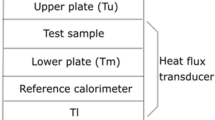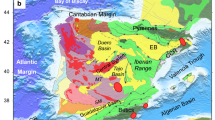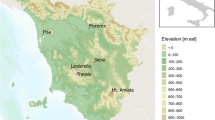Abstract
The geothermal study in India was initiated in 1962 and in the last six decades it grew in concurrence with the international programmes of geothermal study on several fronts, such as, characterizing heat flow for the major geological units; measuring the thermal conductivity of crustal rocks at ambient and elevated temperatures; arriving at the best mathematical model of thermal conductivity from modal mineralogy; calculating radiogenic heat production for the major rock formations; modeling crustal and sub-crustal thermal structure for the stable regions; calculating mantle temperature constrained with seismic velocities and mantle xenoliths; assessing geothermal energy potential regions and using geothermal observations to estimate past climate changes.
Systematic heat flow, thermal conductivity, heat production, and thermal modelling carried out during this period of time led to the refinement of classical thermal models of the continental crust, i.e., from linear-step-exponential heat production model based on linear relationship, to realistic heat production models based on regional geology and regional crustal structure from geophysical studies. In many cases, such studies have also helped in the exploration of geothermal energy potential regions, geo-engineering works and deciphering past climate changes.
Future research goals include to study (i) crustal and upper mantle thermal structure in the unexplored geological provinces, active tectonic zones, sedimentary basins, and hot spring areas of the Indian sub-continent, (ii) thermal structure in the adjoining oceanic regions, occurrence of potential geothermal energy resources, (iii) thermal properties of rocks at elevated temperature and their implications in refining lithospheric thermal model, (iv) linkage between geothermal and meteorological records for past climate change.
Similar content being viewed by others
References
Absar, A., Jangi, B.L., Sinha, A.K., Rai, V. and Ramteke, R. (1996) Concentration of rare alkalies in the geothermal fluids at Puga, Ladakh, J and K — Significance and possibilities of exploitation. In: Pitale U.L. and Padhi R.N. (Eds.), Geothermal Energy in India. Geol. Surv. Spec. Publ., No.45, pp.163–167.
Chopra, N. (2021) Thermal conductivity of the granitoids at ambient and high temperatures from the Singhbhum and Bundelkhand Cratons, India: Implications on crustal thermal modelling. Ph.D. thesis (Unpublished), Andhra Univ., India, pp.212.
Chopra, N. and Ray, L. (2020) Effect of temperature-pressure dependent thermal conductivity on 1-D crustal thermal modelling. Jour. Indian Geophys. Union, v.24(1), pp.1–6.
Chopra, N., Ray, L., Satyanarayanan, M. and Elangovan, R. (2018) Evaluate best-mixing model for estimating thermal conductivity for granitoids from mineralogy: A case study for the granitoids of the Bundelkhand craton, central India. Geothermics, v.75, pp.1–14, doi: https://doi.org/10.1016/j.geothermics.2018.03.011.
Chopra, N., Ray, L., Dey, S. and Mitra, A. (2020) Thermal conductivity, density, petrological and geochemical characteristics of granitoids from Singhbhum Craton, eastern India. Geothermics, v.87, pp.101855, doi: https://doi.org/10.1016/j.geothermics.2020.101855.
Fuchs, S., Forster, H.-J., Braune, K. and Forster, A. (2018) Calculation of thermal conductivity of low-porous, isotropic plutonic rocks of the crust at ambient conditions from modal mineralogy and porosity: A viable alternative for direct measurement? J. Geophys. Res.: Solid Earth, v. 123, pp.8602–8614, doi:https://doi.org/10.1029/2018JB016287.
GSI (1987) Records of the Geological Survey of India, v.118, Pt.6.
GSI (2003) Geological Quadrangle Map (54G), Shivpuri Quadrangle, Madhya Pradesh and Rajasthan, scale 1:2,50,000.
Gupta, H.K., Rao, N., Roy, S., Arora, K., Tiwari, V.M., Patro, P.K., Satyanarayana, H.V.S., Shashidhar, D., Malika, K., Vyasulu, V.A., Goswami. D., Dignat Vyas, G., Srinivas, K.N.S.S.S., Srihari M., Mishra, S., Dubey, C.P., Raju, D.Ch.V., Ujjal, B., Chinna Reddy, K., Babu, N., Rohila, S., Dhar, U., Sen, M., Bhaskar Rao, Y.J., Bansal, B.K., & Nayak, S. (2015) Investigations related to scientific deep drilling to study reservoir triggered earthquake at koyna, India. Internat. Jour. Earth Sci. (Geol Rundsch), v.104, 1511–1522. doi:https://doi.org/10.1007/s00531-014-1128-0
Gupta, M. L. and Gaur, V. K. (1984) Surface heat flow and probable evolution of Deccan volcanism. Tectonophysics, v.105, pp.309–318, doi:https://doi.org/10.1016/0040-1951(84)90210-5.
Gupta, M.L., Sharma, S.R. and Sundar, A. (1991) Heat flow and heat generation in the Archaean Dharwar cratons and implications for the Southern Indian shield geotherm and lithospheric thickness, Tectonophysics, v.194, pp.107–122, doi:https://doi.org/10.1016/0040-1951(91)90275-W.
Gupta, M.L., Sundar, A., Sharma, S.R. and Singh, S.B. (1993) Heat flow in the Bastar Craton, central Indian shield: Implications for thermal characteristics of Proterozoic cratons. Phys. Earth Planet. Inter., v.78, pp.23–31, doi:https://doi.org/10.1016/0031-9201(93)90081-J.
Gupta, M.L., Verma, R.K., Hamza, V.M., Rao, G.V. and Rao, R.U.M. (1970) Terrestrial heat flow and tectonics of the Cambay basin, Gujarat state, India. Tectonophysics, v.10, pp.147–163. doi:https://doi.org/10.1016/0040-1951(70)90104-6.
Hasterok, D., Chapman, D.S. (2011) Heat production and geotherms for the continental lithosphere. Earth Planet. Sci. Lett., v.307, pp.59–70.
Hofmeister, A. (1999) Mantle values of thermal conductivity and the geotherm from phonon lifetimes. Science, v.283, pp.1699–1706.
Hofmeister, A. (2005) Dependence of diffusive radiative transfer on grain size, temperature, and Fe-content: implications for mantle processes. Jour. Geodynamics, v.40, pp.51–72.
Jaupart, C., Mareschal, J-C. and Larotsky, L. (2016) Radiogenic heat production in the continental crust. Lithos, v.262, pp.398–427, doi:https://doi.org/10.1016/j.lithos.2016.07.017.
Kochhar, N. (1983) Tusham ring complex, Bhiwani, India. Proc. Indian Natn. Sci. Acad, v.49, pp.459–490.
Kochhar, N., Vallinayagam, G. and Bhushan, S.K. (1988) Significance of perlite in the Precambrian acid volcanic rocks of western Rajasthan, India. Indian Minerals, v.42, pp.148–152.
Kumar, P. S. and Reddy, G. K. (2004) Radioelements and heat production of an exposed cross section of Archaean crust, Dharwar craton, south India. Earth Planet. Sci. Lett., v.224, pp.309–324, doi:https://doi.org/10.1016/j.epsl.2004.05.032.
Lachenbruch, A.H. (1968) Preliminary geothermal model of the Sierra Nevada. AGU, v.73, pp.6977–6989, doi:https://doi.org/10.1029/JB073i022p06977.
Lachenbruch, A.H. (1970) Crustal temperature and heat production: Implications of the linear heat-flow relation. Jour. Geophys. Res., v.75, pp.3291–3300, https://doi.org/10.1029/JB075i017p03291.
Lachenbruch, A. H., Sass, J. H., Munroe, R. J. and Moses Jr., T. H. (1976) Geothermal setting and simple heat conduction models for the Long Valley Caldera. Jour. Geophys. Res., v.81, pp.769–784, doi:https://doi.org/10.1029/JB081i005p00769.
Lee, W.H.K. and Uyeda, S. (1965) Review of Heat Flow Data. In Terrestrial Heat Flow (pp. 87–190): Amer. Geophys. Union, v.8, DOI:https://doi.org/10.1029/GM008p0087.
Menon, R., Kumar, P. S., Reddy, G. K. and Srinivasan R. (2003) Radiogenic heat production of late Archaean Bundelkhand granite and some Proterozoic gneisses and granitoids of central India. Curr. Sci., v.85, pp.634–638, doi: https://www.jstor.org/stable/24109102.
Nagaraju, P., Ray, L., Ravi, G., Akkiraju, V.V. and Roy S. (2012) Geothermal investigations in the Upper Vindhyan sedimentary rocks of Shivpuri area, central India. Jour. Geol. Soc. India, v.80, pp.39–47
Nagaraju, P. and Roy, S. (2014) Effect of water saturation on rock thermal conductivity measurements. Tectonophysics, 626, pp.137–143. doi:https://doi.org/10.1016/j.tecto.2014.04.007.
Podugu, N. (2015) Heat Flow, Heat Production and Crustal Thermal Structure in the Bundelkhand Croton, Northcentral India: Ph.D. Thesis Osmania University, Hyderabad, India, pp.196.
Podugu, N., Ray, L., Singh, S.P. and Roy, S. (2017) Heat flow, Heat production and Crustal thermal structure in the Archaean Bundelkhand craton: implications for thermal regime beneath the northern Indian shield. Jour. Geophys Res.: Solid Earth, v.122, pp.5766–5788, doi:https://doi.org/10.1002/2017JB014041.
Rao, R.U.M., Verma, R.K., Rao, G.V. and Gupta M.L. (1970) Heat flow at Damua and Mohapani, Satpura Gondwana basin, India. Earth Planet. Sci. Lett., v.7, pp.406–412, doi:https://doi.org/10.1016/0012-821X(70)90082-8.
Rao, G.V. and Rao, R.U.M. (1983) Heat flow in the Indian Gondwana basins and heat production of their basement rocks. Tectonophysics, v.91, pp.105–117, doi:https://doi.org/10.1016/0040-1951(83)90060-4.
Rao, R.U.M., Rao, G.V. and Narain, H. (1976) Radioactive heat generation and heat flow in the Indian shield, Earth Planet. Sci. Lett., v.30, pp.57–64, doi:https://doi.org/10.1016/0012-821X(76)90008-X.
Rao, R.U.M., Roy, S. and Srinivasan, R. (2003) Heat-flow researches in India: Results and perspectives. In: T. M. Mahadevan, B. R. Arora, and K. R. Gupta (Eds.), Indian Continental Lithosphere, Emerging Research Trends. Mem. Geol. Soc. India, no.53, pp.347–391.
Rao, R.U.M., Rao, G.V. and Reddy, G.K. (1982) Age dependence of continental heat flow: fantasy and facts. Earth Planet. Sci. Lett., v.59, pp.288–302.doi: https://doi.org/10.1016/0012-821X(82)90132-7.
Rao, S.E., Ray, L., Khan, T. and Ravi, G. (2021) Thermal conductivity, density and porosity of sedimentary and metamorphic rocks from the Lower and Higher Himalaya, Western Himalaya, India. Geophys. Jour. Int. (under review).
Ray, L. (2002) Crustal Thermal Structure of the Southern Granulite Province, India. Ph.D. Thesis (unpublished), Osmania University, Hyderabad, India, pp.214.
Ray, L., Chopra, N., Hiloidari, S., Naidu, N.N. and Kumar, V. (2021) Temperature dependence of thermal conductivity for granitoids: Implication in crustal thermal modelling. Geophys. Jour. Int., v.227, pp.316–332, doi: https://doi.org/10.1093/gji/ggab191.
Ray, L., Förster, H.-J., Förster, A., Fuchs, S., Naumann, R. and Appelt, O. (2015) Tracking the thermal properties of the lower continental crust: Measured versus calculated thermal conductivity of high-grademetamorphic rocks (Southern Granulite Province, India), Geothermics, v.55, pp.138–149, doi:https://doi.org/10.1016/j.geothermics.2015.01.007.
Ray, L., Förster, H.-J., Schilling, F.R. and Förster, A. (2006) Thermal diffusivity of felsic to mafic granulites at elevated temperatures, Earth Planet. Sci. Lett., v.251, pp.241–253, doi:https://doi.org/10.1016/j.epsl.2006.09.010.
Ray, L., Dey, S., Chopra, N., Mahato, P.P. (2019) Spatial variations of radioelemental concentrations and heat production of the granitoids from the Singhbhum craton, eastern India and their geodynamic implications, India. 56th Annual Convention Indian Geophysical Union (IGU), Hyderabad, India, Oct. 13–16.
Ray, L., Gupta, R.K., Chopra, N., Gopinadh, D. and Dwivedi, S.K. (2021) Thermal and physical properties of Deccan basalt and Neoarchean basement cores from a deep scientific borehole in the Koyna”Warna seismogenic region, Deccan Volcanic Province, western India: Implications on thermal modeling and seismogenesis. Earth Space Sci. doi: https://doi.org/10.1029/2021EA001645
Ray, L., Dey, S., Chopra, N. and Mahato, P.P. (2021) Low radioelemental concentrations and heat production of the granitoids of the Singhbhum Craton, eastern India and its geodynamic implications. Geophys. Jour. Int. (Under Review)
Ray, L., Kumar, P.S., Reddy, GK., Roy, S., Rao, G.V., Srinivasan, R. and Rao, R.U.M. (2003) High mantle heat-flow in a Precambrian granulite province: Evidence from southern India. Jour. Geophys. Res.: Solid Earth, v. 108(B2), pp.2084, doi:https://doi.org/10.1029/2001JB000688.
Ray, L., Nagaraju, P., Singh, S.P., Ravi, G and Roy, S. (2016) Radioelemental, petrological and geochemical characterization of the Bundelkhand craton, central India: Implication in the Archean geodynamic evolution, Internat. Jour. Earth Sci. (Geol Rundsch), v.105, pp.1087–1107, doi:https://doi.org/10.1007/s00531-015-1229-4.
Ray, L., Roy, S. and Srinivasan, R. (2008) High radiogenic heat production in the Kerala Khondalite Block, Southern Granulite Province, India, Internat. Jour. Earth Sci., v.97, pp.257, doi:https://doi.org/10.1007/s00531-007-0278-8.
Ray, L., Bhattacharya, A. and Roy, S. (2007) Thermal Conductivity of Higher Himalayan Crystallines from Grahwal Himalaya, India, Tectonophysics, v.434, pp.71–79, doi:https://doi.org/10.1016/j.tecto.2007.02.003.
Roy, S. and Rao, R.U.M. (1999) Geothermal investigation in the 1993 Latur earthquake area Deccan Volcanic Province, India. Tectonophysics, v.306, pp.237–252, doi:https://doi.org/10.1016/S0040-1951(99)00051-7.
Roy, S. and Rao, R.U.M. (1996) Regional heat flow and the perspective for the origin of hot springs in the Indian shield. Visesa Prakasana-Bharatiya Bhuvaijñanika Sarveksana. Geol. Surv. India, v.45, pp.39–40.
Roy, S. and Rao, R.U.M. (2000) Heat flow in the Indian shield. J. Geophys. Res., v.105, pp.25,587–25,604, doi:https://doi.org/10.1029/2000JB900257.
Roy, S. and Rao, R.U.M. (2003) Towards a crustal thermal model for the Archaean Dharwar craton, southern India. Phys. Chem. Earth., v.28, pp.361–373, doi:https://doi.org/10.1016/S1474-7065(03)00058-5.
Roy, S. and Chapman, D.S. (2012) Borehole temperatures and climate change: Ground temperature change in south India over the past two centuries, Jour. Geophys. Res., v.117, pp. D11105, doi:https://doi.org/10.1029/2011JD017224.
Roy, S. and Mareschal, J.C. (2011) Constraints on the deep thermal structure of the Dharwar craton, India, from heat flow, shear wave velocities, and mantle xenoliths. Jour. Geophys. Res., v. 116, pp.B02409, doi:https://doi.org/10.1029/2010JB007796.
Roy, S., Harris, R. N., Rao, R. U. M. and Chapman, D. S. (2002) Climate change in India inferred from geothermal observations. Jour. Geophys. Res., v.107(B7), pp.2138, doi:https://doi.org/10.1029/2001JB000536.
Roy, S., Ray, L., Kumar, P.S., Reddy, G.K. and Srinivasan, R. (2003) Heat flow and heat production in the Precambrian Gneiss-granulite Province of Southern India. Mem. Geol. Soc. India, v.50, pp.177–191.
Roy, S., Ray, L., Bhattacharya, A. and Srinivasan, R. (2007) New heat flow data from deep boreholes in the greentone-granite-gneiss and gneiss-granulite provinces of south India, DCS-DST Newsletter, v. 17, No. 1.
Roy, R.F., Blackwell, D.D. and Birch, F. (1968) Heat generation of plutonic rocks and continental heat flow provinces. Earth Planet. Sci. Lett., v.5, pp.1–12, doi:https://doi.org/10.1016/S0012-821X(68)80002-0.
Roy, S., Ray, L., Bhattacharya, A. and Srinivasan, R. (2008) Heat flow and crustal thermal structure in the Late Archaean Closepet Granite batholiths, South India. Internat. Jour. Earth Sci. (Geol Rundsch), v.97, pp.245–256, doi:https://doi.org/10.1007/s00531-007-0239-2
Roy, S. and Ray, L. (2004) Examination of subsurface temperature regime along the proposed tunnel alignment in Tapovan- Vishnugad hydro power project, Uttaranchal: Report submitted to Water and Power Consultancy Services (India) Ltd.
Roy, S. and Ray, L. (2005) Examination of subsurface temperature regime along the proposed tunnel alignment in Loharinag-Pala hydro power project, Uttaranchal: Report submitted to Water and Power Consultancy Services (India) Ltd.
Schilling, F.R. (1999) A transient technique to measure thermal diffusivity at elevated temperatures: European Jour. Mineral., v.11, pp.1115–1124.
Shankland, T., Nitsan, U., Duba, A. (1979) Optical absorption and radiative 880 heat transport in olivine at high temperature. Jour. Geophys. Res., v.84, pp.1603–1610.
Sundar, A., Gupta, M.L. and Sharma, S.R. (1990) Heat flow in the Trans-Aravalli igneous suite, Tusham, India. Jour. Geodyn., v.12, pp.89–100.
Verma, R.K. and Rao, R.U.M. (1964) Heat flow measurements in India. Bull. NGRI, v.2(4), pp.142–151.
Acknowledgements
I am indebted to all my seniors who have worked for decades since the born of heat flow studies in CSIR-NGRI in 1962. Their unswerving work has helped to attain achievements in a diverse field of geothermal study and has been recognised globally by the geothermal community and International Heat Flow Commission. I am especially grateful to Dr. R.U.M. Rao and Dr. G. V. Rao for their inspiration, support, scientific discussion/contribution in the demand of the heat flow group, even after superannuation. I also thank to the Geological Survey of India, Atomic Mineral Directorate, Central Ground Water Board, State Ground Water Board, Tata Steel, and many private agencies for helping in different aspects from last few decades, e.g., getting deep boreholes for temperature measurements, providing borehole core samples, sharing borehole lithology, etc. I thank research students of the Thermal Geophysics group (N. Chopra, S. E. Rao, and others) and supporting persons (S. Seshikanth and K. Mahesh) for their support and enthusiasm in the last few years which help me to work in few new dimensions in addition to the earlier research domains. Thanks to Dr. O.P.Pandey and anonymous reviewer for their critical and constructive comments that have helped to improve the paper. My sincere thanks to earlier Directors, Dr. H.K. Gupta, Dr. VP. Dimri, Dr. M. K. Sen, and present Director Dr. V.M. Tiwari, for their continuous support to Heat flow/Thermal Geophysics Group. The reference number of the paper is NGRI/Lib/2021/Pub-38.
Author information
Authors and Affiliations
Corresponding author
Rights and permissions
About this article
Cite this article
Ray, L. Heat Flow Studies in India: An Update. J Geol Soc India 97, 1214–1225 (2021). https://doi.org/10.1007/s12594-021-1851-7
Received:
Accepted:
Published:
Issue Date:
DOI: https://doi.org/10.1007/s12594-021-1851-7




